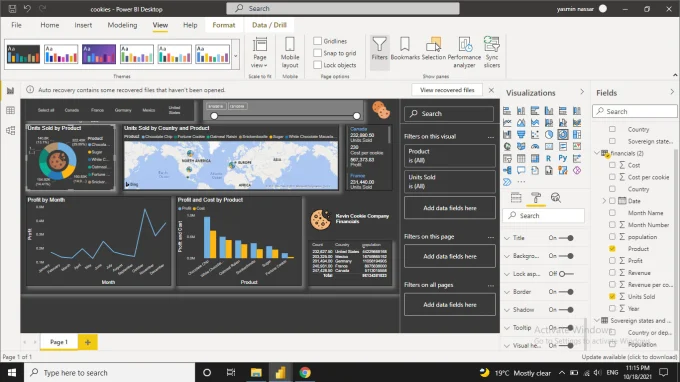The Fastest Way to Data Analysis with Microsoft Power BI

As businesses become more and more reliant on technology, a lot of times it seems as if
there are endless amounts of data everywhere. The key to successfully turning this data
into useful information is by analyzing it with Microsoft Power BI.
Power BI is a Microsoft data visualization and analytics tool that helps you turn your
disparate business data into a single, shared view.
To connect with Power BI, you must first create a Power BI organization on your
Microsoft account. A Power BI organization is simply an online repository of your data
and associated reports and dashboards that can be accessed by anyone accessing the
Portal.
What is Microsoft Power BI?
Microsoft Power BI is a data analysis and graphing tool that allows users to quickly and
easily generate reports and analyses of data. That is why, people get power bi træning
that allow users to interact with data in various ways, including through visual
representations and easy-to-use tools. Power BI can be used by individuals or teams,
making it a valuable tool for use in both personal and business contexts.
How can Data Analysis help me as a journalist?
Data analysis is the process of turning raw data into meaningful information. This is
essential for journalists who need to uncover trends, analyse data, and draw
conclusions that help inform their reporting. In this blog post, we’ll discuss how Power
BI can help journalists quickly and easily analyse data.
Power BI makes it easy to explore your data in ways that let you see patterns and
correlations. For example, you can filter your data by column or row to focus on specific
pieces of information.
You can also create custom visualizations that show the relationships between different
pieces of data. This helps journalists understand the data more clearly and make
informed decisions about how to report on it.
Power BI also allows you to export your data in a variety of formats, including PDF,
Excel, JSON, and Tableau Viz. This makes it easy for journalists to share your findings
with others in a clear and concise way. Ultimately, using Power BI helps journalists
become better analysts and better reporters.
What are the Benefits of Microsoft Power BI?
One of the benefits of using Microsoft Power BI is that it makes data analysis fast and
easy. With Power BI, you can quickly explore and understand your data, making it
easier to make informed decisions. Additionally, Power BI offers a variety of features
that make data analysis more efficient, such as predictive analytics and visuals.
Power BI is a data-driven service that enables users to explore, visualize, and share
their data. It offers powerful tools that allow you to create stunning visuals and
interactive dashboards with a few clicks. You can use Power BI to discover new insights
into your business.
For example, you can use Power BI to track the performance of your products and
compare it against previous years. In addition, you can perform predictive analytics and
create intelligent reports for all of your internal stakeholders in minutes, using just a
few keystrokes.
The Power BI Analyze tab is used to build dynamic visualizations from data collected
from multiple sources, such as Excel files or SharePoint lists. When working with large
amounts of data on Excel spreadsheets,
What is a Story Map?
Story mapping is a way of capturing and organizing the data you use to inform your
business decisions. By breaking down data into its constituent parts, you can more
easily understand how it affects your organization. Story maps make it easy to see how
data changes over time and how different pieces of information connect to one another.
Data is just data until a story map is applied.
Story maps make it easy to see how data changes over time and how different pieces of
information connect to one another. Once you have identified your key stories, you can
use them to inform business decisions.
For instance, if you find that sales increase whenever customers are referred by their
friends, then you know that you need to create more Facebook accounts for customers
who come into your store and that you should direct Facebook friends to your website
more often. If you dont, then new customers may never become regular customers
Using your story map in Microsoft Power BI
If youre anything like me, you spend a majority of your time analyzing data. Whether
it's pulling data from various sources, drilling down into trends, or building models to
make predictions, data analysis is an essential part of any business.
One tool that can make analysis a breeze is Microsoft Power BI. With its wide range of
features and easy-to-use interface, Power BI can help you quickly and easily get your
data analysis done. In this blog post, well show you how to use your story map to speed
up your data analysis process with Power BI.
What is a story map?
A story map is a visual way to represent the structure and flow of a story. It helps us
understand how different parts of the story connect to each other and what outcomes
are possible. Story maps are great for data analysis too!
With a story map in hand, you can quickly see which data points are related and which
ones need further investigation. You can also see how changes in one part of the story
will affect other parts. This information can help you make informed decisions about
how to analyze your data.
How do I create a story map in Power BI?
When you're working with data in Microsoft Power BI, you can use charts and visuals to
help you understand the data and make insights. In this tutorial, well show you how to
create a simple chart using Power BIs Charting feature.
First, open your dataset in Power BI. You can find datasets in the Analysis tab or on the
Data tab in the ribbon.
Next, click the Charting button on the ribbon and select Chart from the list of options.
You ll see the Charting window appear. In this window, you can configure how your
chart will look. Well just enter some basic information here and click the Create button.
The first thing youll need to do is select a dataset from which to draw your charts data.
In our example, well select Sales Data from our Sales database.
Next, lets define some basic parameters for our chart. Well choose a Vertical Axis
option to plot sales figures against time (in months). We;ll also choose a Horizontal Axis
option to plot sales figures against each other (between Product A and Product B).







